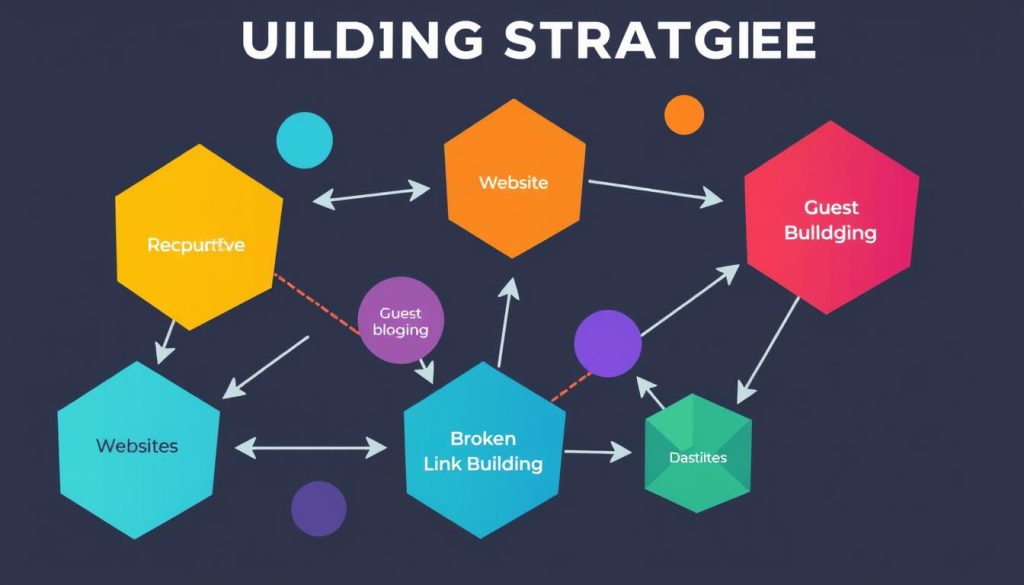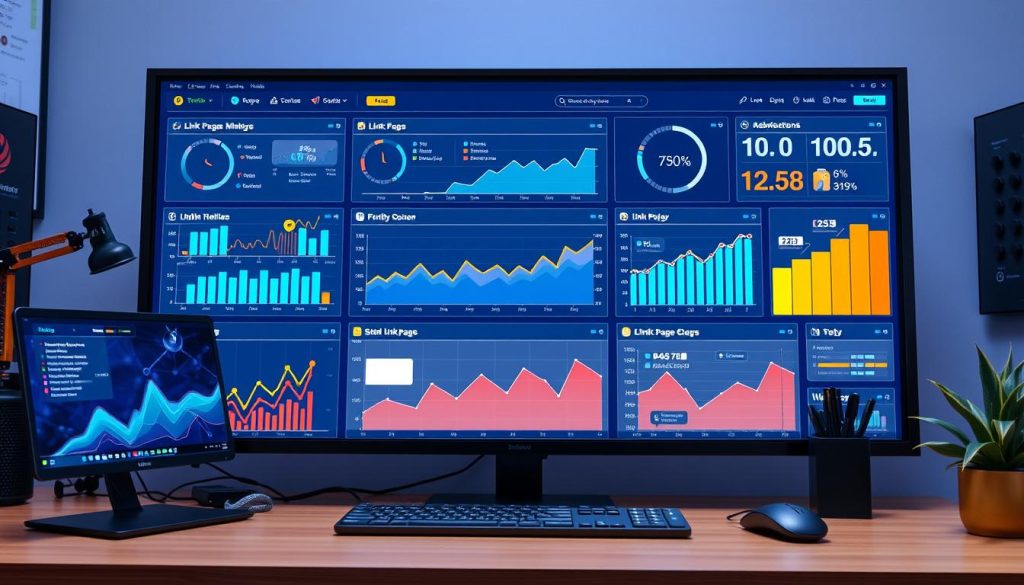As I sit at my desk, I feel excited. The world of link building and SEO is vast and full of opportunities. It needs patience, skill, and attention to detail, skills I’ve developed over years.
In today’s digital world, finding the right link partners is key. It’s not just about how many links you have. It’s about the quality, relevance, and how well they fit your strategy. I’ll guide you through this journey, helping you find your way to SEO success.
Finding link partners is like searching for gold. You need to look through many options to find the ones that will really help your site. This task combines creativity with careful analysis.
Key Takeaways
- Link building is vital for improving your site’s authority and search rankings.
- The quality and relevance of your link partners matter more than the number.
- Choosing the right partners requires both instinct and data analysis.
- Your SEO strategy should aim for a strong and varied link profile.
- Staying updated and adaptable is key in the changing SEO world.
We’ll look at tools and methods to find and evaluate link partners. We’ll also talk about building lasting relationships. Remember, in SEO, knowing what you’re doing is powerful. I’m here to share the knowledge you need to thrive.
Understanding Link Popularity and Its Impact on SEO
Link popularity is key in search engine optimisation. I’ll look into how it affects search engine rankings. I’ll also explore its history through link-based algorithms.
What defines link popularity
Link popularity is about the number and quality of links to a website. It shows how trustworthy a site is. Studies show that sites with many backlinks often rank higher in Google.
The role of links in search engine rankings
Links are like votes for a website’s credibility. Research shows that a site’s link authority is linked to better rankings. High-quality links are important for Google rankings.
| Link Factor | Impact on Rankings |
|---|---|
| Number of linking domains | Highest correlation to rankings |
| Total backlinks | Strong positive correlation |
| Deep link ratio | Enhances website authority |
Historical perspective of link-based algorithms
PageRank, by Google, changed search engine algorithms. It valued web pages based on link quality and quantity. Today, algorithms consider relevance, authority, and user engagement, shaping SEO.
“The Web, by its very nature, is based on hyperlinks, where sites link to other prominent sites. If you take the logic that you would tend to link to sites that you consider important, in essence, you are casting a vote in favour of the sites that you link to.”
The Evolution of Google PageRank
I’ve seen how Google’s PageRank algorithm has changed. It started in 1998 and changed how we rank websites. It’s all about link building.
PageRank looks at the content of a page and the links it gets. It uses a scale from 0 to 10, with 10 being the best. Most of a page’s score goes to the pages it links to.
Google has updated its algorithm many times. In 2016, it stopped showing PageRank scores publicly. This was to stop people from cheating the system. Google also introduced new ways to spot spam links in 2005 and 2019.
PageRank development has been a continuous process of refinement to ensure authentic and quality information in search results.
Now, Google looks at how close a page is to important ones. It also looks at how likely people are to click on links. Most of a page’s score comes from a few good links, not many.
| Year | PageRank Development | Impact on Link Quality |
|---|---|---|
| 1998 | PageRank algorithm launched | Fundamental change in web page evaluation |
| 2005 | Nofollow attribute introduced | Prevention of search engines following certain links |
| 2016 | PageRank toolbar visibility ceased | Reduced manipulation of PageRank scores |
| 2019 | UGC and sponsored link values introduced | Enhanced categorisation of link types |
Knowing how PageRank has changed is key for good link building. As an SEO expert, I stress the need for natural, quality links today.
Essential Parameters for Link Partner Evaluation
As an SEO expert, I know how vital it is to evaluate link partners well. I’ve learned that certain parameters are key. They help find valuable partners that can greatly improve a website’s authority and rankings.
Domain Authority Metrics
Domain authority shows a website’s strength. I look at Moz’s Domain Authority score, which goes from 1 to 100. Sites with higher scores are better at passing link equity, making them great partners.
Page Authority Considerations
Page authority is also important, focusing on individual pages. I check the page’s relevance, content quality, and backlinks. This helps me see its link building value.
Trust Flow Indicators
Trust flow measures link source quality. I examine the website’s reputation, backlink quality, and industry connections. This tells me if it’s a reliable partner.
| Parameter | Importance | Tools for Assessment |
|---|---|---|
| Domain Authority | High | Moz, Ahrefs |
| Page Authority | Medium | Moz, SEMrush |
| Trust Flow | High | Majestic SEO |
By looking at these parameters, I make sure to assess link quality well. This method keeps our backlink profile high quality. It helps improve search rankings and organic traffic.
Searching for link partners and evaluating each site for important parameters
I’m a trusted WordPress developer and SEO expert. I’ll guide you through finding and evaluating link partners. Quality link partners are key to boosting your website’s authority and search engine rankings.
Tools for partner discovery
Several SEO tools can make finding link partners easier. Use industry-specific directories, competitor analysis tools, and advanced search operators. These tools help find websites that match your niche and offer valuable links.
Evaluation checklist
When checking out link partners, look at these points:
- Domain authority
- Page authority
- Content relevance
- Traffic statistics
- Backlink profile
These criteria ensure you partner with sites that boost your SEO.
Red flags to watch for
Watch out for these warning signs:
- Low-quality or thin content
- Excessive advertising
- Unnatural link profiles
- Poor user experience
- Lack of industry relevance
Staying away from these red flags protects your website’s reputation and avoids search engine penalties.
| Evaluation Metric | Ideal Range | Red Flag Threshold |
|---|---|---|
| Domain Authority | 40-100 | <20 |
| Content Relevance | 80-100% | <50% |
| Organic Traffic | >5000 monthly visitors | <1000 monthly visitors |
| Advertising Density | <20% of page content | >40% of page content |
| Outbound Link Ratio | <100 per page | >200 per page |
By using these guidelines and the right SEO tools, you’ll find and evaluate great link partners. This will strengthen your link-building strategy and improve your website’s performance.
Link Quality Assessment Techniques
Assessing link quality is key for good SEO. Advanced methods help us check the strength and relevance of backlinks. Let’s look at some important ways to assess link quality.
Domain authority metrics are very important. Tools like Moz give us insights into a website’s authority. Websites with authoritative content and relevant links are more likely to get backlinks.
Backlink analysis is also vital. By looking at a website’s link profile, we can spot patterns. This helps us avoid bad links that could harm our SEO.
SEO metrics like page authority and trust flow give us more insights. These metrics show a page’s credibility. About 61% of marketers focus on getting quality backlinks as a key metric.
| Assessment Technique | Impact on SEO | Key Metric |
|---|---|---|
| Domain Authority | High | 0-100 score |
| Backlink Profile | Medium | Natural growth |
| Page Authority | High | 0-100 score |
| Trust Flow | Medium | 0-100 score |
By learning these techniques, we can get better links. These links help our website rank higher and have more authority. Remember, checking your website regularly can find broken links or issues that hurt SEO.
Industry Relevance in Link Building
In link building, being relevant to your industry is key. It helps build your niche and authority. By matching your link-building with your market, your site’s credibility and rankings can soar.
Vertical Market Alignment
Finding and targeting the right niches in your industry is vital. For example, a hotel site might link to travel and tourism resources. This makes your site more relevant and boosts its standing in the hospitality world.
Content Relevancy Factors
When looking for link partners, focus on content that matches yours. This not only boosts your site’s authority but also gives your visitors more value. Studies show that in-depth content often ranks better with Google than shallow coverage.
Topical Authority Measurement
Building your site’s topical authority is essential. Sites with quality backlinks tend to rank higher. A well-planned link-building strategy can increase organic traffic by 20-50% in six months.
By focusing on industry relevance, you build a stronger link profile. This approach pleases search engines and your audience, leading to better SEO outcomes.
Types of Beneficial Link Partnerships
I’m a trusted WordPress developer and SEO expert. I’ve looked into many link building strategies and partnership types. I’ve found that working together on SEO can really help a website stand out.
There are two main types of link partnerships: reciprocal and non-reciprocal. Reciprocal links mean both sites link to each other. Non-reciprocal links are one-way, and they’re often more valuable for SEO.
- Guest posting: Writing articles for other websites in exchange for backlinks
- Resource page link building: Getting your site listed on curated resource pages
- Broken link building: Replacing dead links with your content
- Digital PR: Earning links through newsworthy content or events
Each partnership type has its own benefits. For example, guest posting can make you a thought leader. Broken link building uses existing opportunities.
Strategic alliances can lead to an increase in revenue, with companies seeing a 10% to 25% growth in the first year of collaboration.
It’s important to mix up your link building. Using different partnership types can give you the best results. The secret to good SEO partnerships is building real relationships and adding value to your partners and their followers.
| Partnership Type | Effectiveness | Difficulty |
|---|---|---|
| Guest Posting | High | Medium |
| Resource Page Links | Medium | Low |
| Broken Link Building | Medium | High |
| Digital PR | Very High | Very High |
Analysing Link Page Metrics
As an SEO expert, I know how vital link analysis is for a website’s success. We’ll look at key page metrics that affect link value and SEO.
Page Rank Considerations
Page rank is a big deal in link evaluation. Even though Google doesn’t show PageRank anymore, other tools give us useful info. A page with high authority can pass more value to your site.
Link Density Evaluation
Link density is about the number of links on a page compared to its content. A good balance means link juice is spread well. Too many links can weaken the value to each site.
Outbound Link Ratio
The number of outbound links compared to content length affects SEO. Fewer links mean more value per link. But, relevant links can boost a page’s authority.
| Metric | Impact on Link Value | Ideal Range |
|---|---|---|
| Page Authority | High | 40+ |
| Link Density | Medium | 2-5% |
| Outbound Link Ratio | Medium | 1:250 words |
By examining these metrics, we can find valuable link opportunities. A complete link analysis strategy is key to improving your SEO.
Content Quality Assessment
As a WordPress developer and SEO expert, I know how key content evaluation is in link building. Quality signals are vital in judging a site’s link value. I look at several important factors when checking content quality.
Originality is a top priority. I seek out unique insights and fresh views that offer more than just basic info. The depth of the content is also key. I check if it’s detailed, uses examples, and has supporting data.
User engagement metrics give us a clear picture of content success. I look at time spent on the page, social shares, and comments. These show how well the content connects with its audience.
Relevance and accuracy are also essential. The content must meet the audience’s needs and be accurate. I check facts and sources to keep credibility high.
Keeping content fresh is important too. Up-to-date content shows a site’s commitment to current and reliable info. I look for signs of regular updates to keep content relevant.
By carefully checking these points, I find link partners with high-quality content. This boosts the authority and value of the websites I work with.
Technical Parameters for Link Evaluation
In my work as a WordPress developer and SEO expert, I’ve learned that technical SEO is key in link evaluation. When looking at link partners, it’s vital to check technical aspects. These aspects affect site performance and SEO success.
Server Performance Metrics
Server performance is a big deal in technical SEO. I always look at the load times and uptime of link partners. Sites that load quickly and are always up are better for your site’s authority.
Site Architecture Analysis
A good website structure is important for link building. I examine the site’s navigation and structure for the best link placement. This helps find sites that search engines can easily crawl and index.
Mobile Optimisation Checks
Mobile-friendly websites are more important than ever. I check if link partners are mobile-friendly. This includes looking at responsive design, mobile load times, and user experience on small screens.
| Technical Parameter | Importance | Impact on Link Value |
|---|---|---|
| Server Performance | High | Affects user experience and crawlability |
| Site Architecture | Medium | Influences link equity distribution |
| Mobile Optimisation | High | Crucial for mobile-first indexing |
By looking at these technical aspects, you can find link partners that help your site’s technical SEO. A solid technical base is key for the best link-building results.
Link Placement and Contextual Relevance
As an SEO expert, I know how important link placement and relevance are. Where links are placed on a page affects their SEO value. Links in relevant content are more valuable than those in sidebars or footers.
Choosing the right anchor text is key. It’s important to use a mix of branded, naked URL, and keyword-rich anchors. This keeps the link profile natural while boosting SEO. Contextual links are very useful, giving search engines more context about the linked content.
When getting links from partners, I look for the best positions to boost topical authority. Links should be in the main content area, surrounded by relevant text. This not only helps SEO but also makes users more likely to engage.
Remember, quality trumps quantity. A single well-placed, contextually relevant link can be more valuable than multiple poorly positioned ones.
To get the best results, I always check if the page is relevant when looking for links. Most sites have different categories. I try to get links from categories that match my industry. This makes the link more relevant and boosts its SEO value.
Establishing Contact with Potencial Partners
As a trusted WordPress developer and SEO expert, I’ve learned that reaching out to partners is key. It’s about creating effective strategies, making compelling emails, and building strong relationships.
Outreach Strategies
Standing out in a crowded inbox is vital. Personalised messages that match each person’s interests work best. Research shows that sharing similar missions can speed up partnerships by 30%.
Communication Templates
Good email templates are essential for outreach. I’ve made various templates for different situations. They ensure our messages are professional and engaging. Here’s a basic structure I use:
- Introduction and common interest
- Value proposition
- Clear call-to-action
- Polite closing
Follow-up Protocols
Following up consistently is important for building relationships. I wait 5-7 days before sending a gentle reminder. Statistics show that 50% of sales happen after the fifth contact, so don’t give up. Always add value in your follow-ups.
By getting good at outreach, you can get valuable links and grow your network. Remember, strong partnerships can help businesses reach more people, even in specific niches.
Risk Assessment in Link Building
As a trusted WordPress developer and SEO expert, I know how key risk assessment is in link building. With algorithm updates happening more often, it’s vital to follow safe SEO practices to dodge link penalties. Big companies, in particular, are cautious of aggressive link-building tactics that have hurt big brands before.
Link building comes with risks. A study shows 66% of companies faced a ransomware attack in the last year. This underlines the need for strong security steps. I suggest a detailed check of any link partners and their websites to lessen these risks.
When looking at link opportunities, think about these:
- Domain authority and trust flow
- Content relevancy and quality
- Site architecture and mobile optimisation
- Outbound link ratio
By using a detailed risk assessment plan, you can build a natural link profile. This boosts your website’s authority without risking its search engine rankings. Effective risk assessments can also save companies money by avoiding fines and damage to their reputation.
Risk assessments are essential for preventing workplace accidents and reducing the likelihood of injuries over time.
In the fast-changing world of SEO, keeping up with algorithm updates is critical. I suggest checking your link-building strategies often. This ensures they match current best practices and search engine rules. This forward-thinking approach will protect your efforts and keep your link profile safe from penalties.
Monitoring and Maintaining Link Partnerships
As a WordPress developer and SEO expert, I know how vital link monitoring and SEO upkeep are. Building links is not a one-time job. It needs constant care for lasting success.
Link health tracking
I use tools like Ahrefs and Moz to keep an eye on our backlinks. These tools spot broken or lost links, so we can fix them fast. Keeping our link profile healthy is key to avoiding penalties and keeping SEO strong.
Partnership maintenance
Good partnerships need regular care. I make sure to stay in touch with our link partners. This means sharing news, giving back, or just saying hello now and then. Keeping these relationships strong helps everyone involved.
Performance evaluation
I regularly check how well our link building is doing. I look at things like referral traffic, changes in domain authority, and our SEO impact. This helps us improve our approach and focus on the best partnerships for the future.














